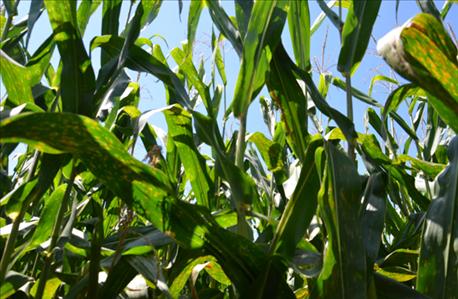August 29, 2016

Many articles have been written about cover crops and why they should be grown. But one of those reasons needs to be emphasized. I scouted several cornfields near Versailles in mid-July. Most of them were pollinating or had just completed the pollination process.
Fields planted after soybeans generally had very little leaf disease. Fields planted after corn had different levels of leaf disease, mostly gray leaf spot. The grower uses cover crops on only a few acres.

NO NEED TO SPRAY: Marshall Alford doesn’t spray fungicides. The no-tiller who also uses cover crops says he hasn’t seen a situation where he thought a foliar fungicide would pay.
On the same day, I also scouted cornfields at Marshall Alford’s farm about 25 miles away. He planted hybrids with some of the same genetics as the first fields I scouted. Alford has been a pioneer of no-till farming for 31 years. He first delved into cover crops about 25 years ago.
Marked difference
I have watched the fields of both growers for the past nine years. It never ceases to amaze me that I see very few leaf diseases in Alford’s corn. I could see dead wheat plant residue covering the ground this year. After scouting several fields, we could find only a couple of lesions from northern corn leaf blight and no lesions from gray leaf spot.
What are possible reasons for the difference on these two farms? All farming operations are different, but one thing that stands out is the consistent use of cover crops at Alford’s farm.
So why would cover crops prevent leaf diseases?
Some corn diseases are spread from spores on the ground from the previous crop debris. They are splashed by rain onto lower leaves and stalks. We know crop rotation reduces diseases and insects. A few years ago, the three-crop rotation of corn-soybeans-wheat was very popular. We had fewer diseases and insects.

FUNGICIDE NEEDED: You could make a case for spraying this field, where gray leaf spot is ramping up, and pollination and grain fill are underway.
My theory is that cover crops provide the physical barrier of a second layer for covering disease organisms. Pathogens are deprived of their favorite host to stay viable — corn plant tissue.
The primary cause of most fungal corn diseases is rain splashing spores onto leaves. Secondary infections occur when the spores are blown in by wind. But that generally happens later in the season; by then, there is reduced potential for disease to cause substantial damage.
Real-world observations
I don’t have any data or even side-by-side comparisons to prove this theory. Yet my observations repeated over five growing seasons on two separate farms growing hybrids with identical genetics may be just as relevant.
I have visited Alford’s fields every year for the last nine years, and I’m always amazed at the very low level of corn disease. A few years ago he had a significant amount of northern corn leaf blight, mostly from secondary infection when most farms were devastated by this pathogen. Alford has never used foliar fungicides because he has never thought he needed them.
Nanda is president of Agronomic Crops Consultants LLC, Indianapolis. Email him at [email protected], or call him at 317-910-9876.
You May Also Like




